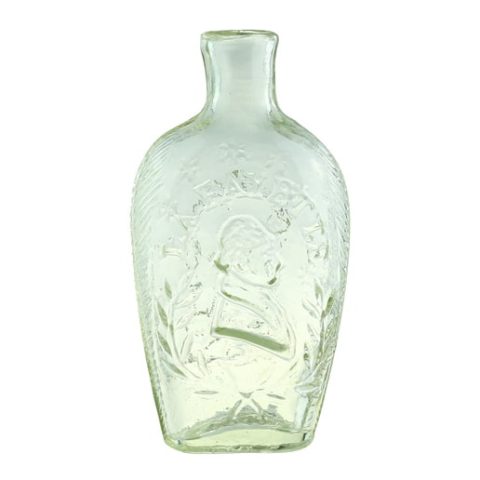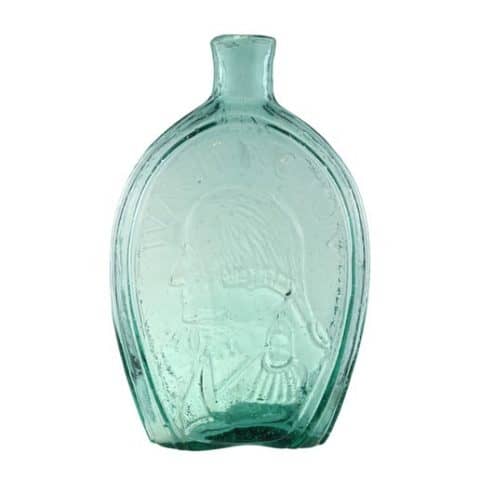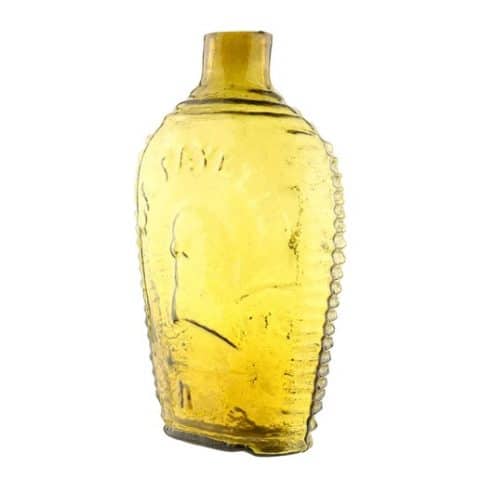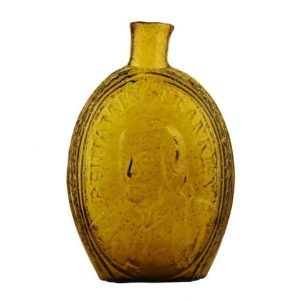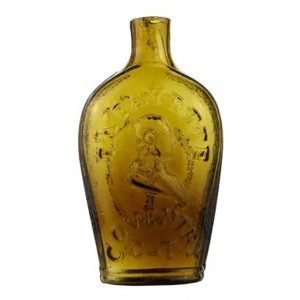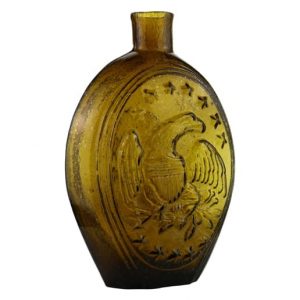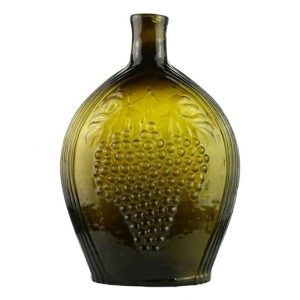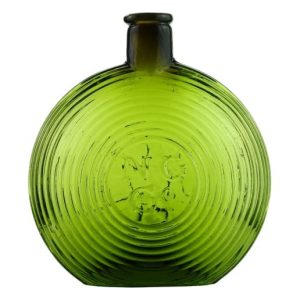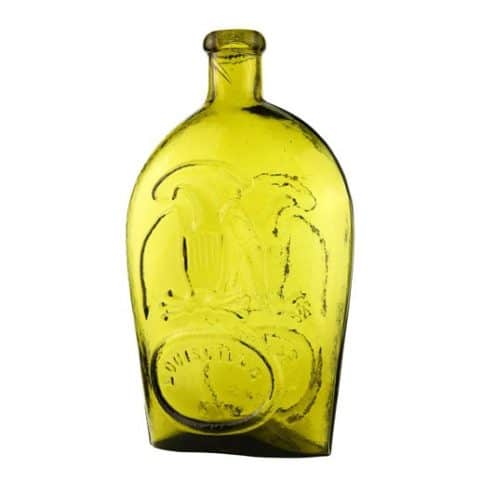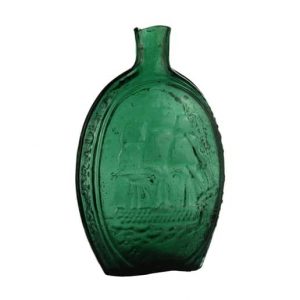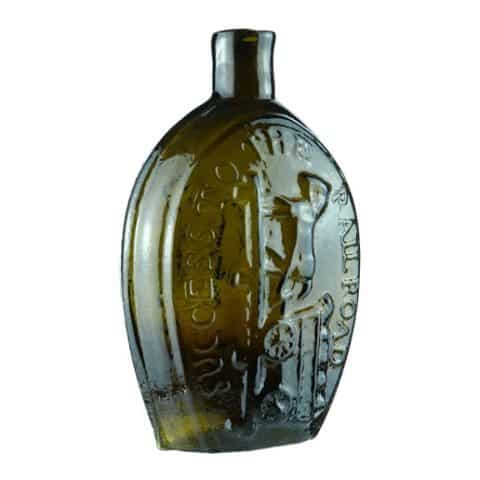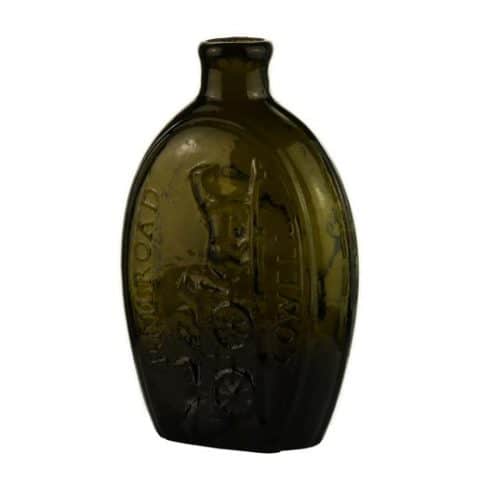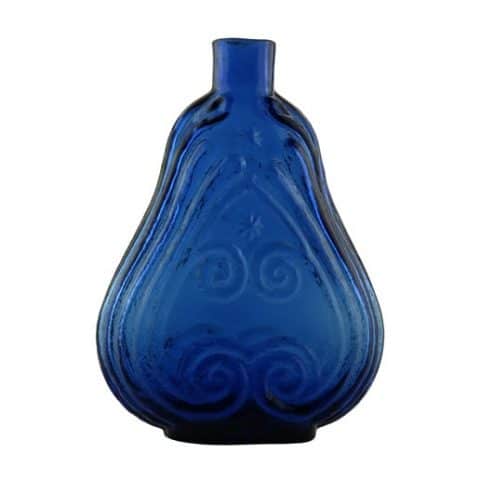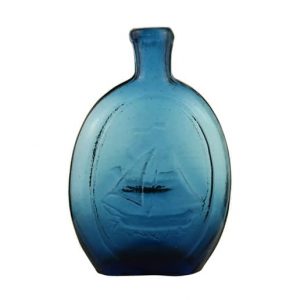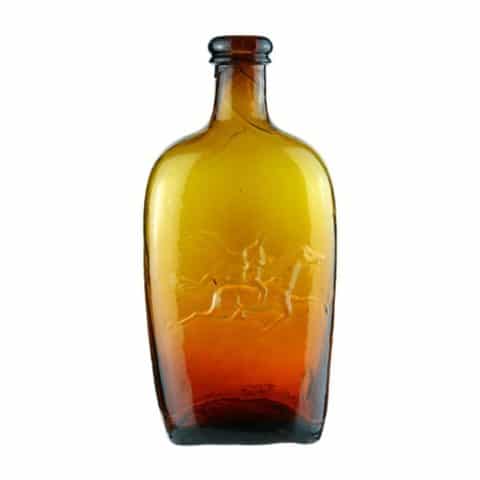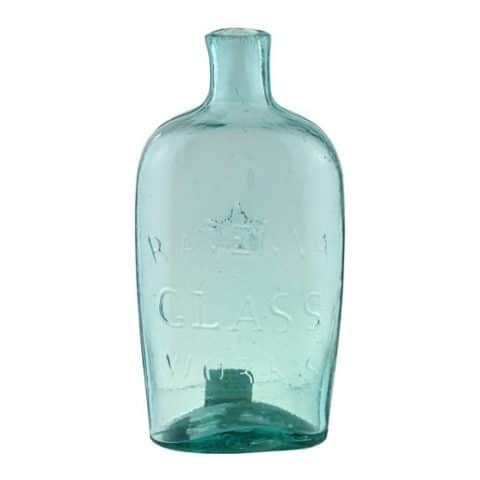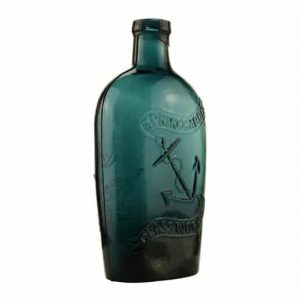GXV-17 • “Ravenna Glass Works” Flask
GXV – 17
“Ravenna Glass Works”
Plain Lettered Flask
Ravenna Glass Works, Ravenna, Ohio
Olive Yellow Pint
Provenance: John Fifer Collection, Ex Darl Fifer Collection

The olive-yellow glass color on our GXV-17 embossed “Ravenna Glass Works” flask is extraordinary. The pint flask is typically found in a golden amber though aqua examples have also been recorded.
The GXV-17 inscription is embossed on the flask face in three straight lines reading ‘RAVENNA GLASS WORKS’. “Ravenna” is arched in the first line. The sans-serif typography is delicate, smaller, and more spaced out than the similar pint GXIII-83 flask that has an embossed 5-pointed star on the reverse side of the flask. The reverse of this flask has no embossing and is smooth. The base and edges of the flask are also smooth. There is a rather sloppy applied ring on the neck to create the flask mouth which adds to the fine character of this flask.
The Ravenna Glass Works, or Company, had a troubled history with at least five incarnations during the period between 1857 and 1893. They are primarily known to collectors for their fruit jars and flasks that are embossed with the “Ravanna Glass Works” name or initials, “R.G.W.”
The first Ravenna Glass Company dates from 1857 to about 1860 or even a little later to April 1861. A grocer named Seth Day, his wife, Mary, Ebenezer and Frances F. Spaulding, plus Samuel H. and Helen F. Terry, under the banner of the Ravenna Glass Co., purchased three parcels of land in Ravenna, Ohio in August and September of 1857 and transferred the titles to the Ravenna Glass Company. Day apparently converted his store into the sales vehicle for the fledgling glass works.
An advertisement in the October 31, 1857 issue of the Cleveland Leader called the firm “Manufacturers of All Kinds of Green Glass Ware,” featuring especially druggist’s ware, although it also offered “vials, in every variety, Caster Oil, Packing, flask and globe bottles, Cap Jars, Demijohns, &c. Also Porter, Mineral Water and Wine bottles, Ink Stands, Ink bottles, Glass Milk Pans, &c., &c.” See the Ravenna Glass Works Air-Tight Fruit Jar which was produced during this period.

Our smooth based GXV-17 Ravenna Glass Works flask was probably made at the third Ravenna Glass Co. from 1863 to 1864. The glassworks was sold at a sheriff’s sale on April 20, 1861, for $2,783.34 to John and George Forder. Just over a year later, the sheriff again sold the property to George Messenger for $2,400 on July 19, 1862. The Ohio Farmer reported on the new arrangement on January 21, 1863 when it reported that, T. J. Terry was in operation producing all kinds of druggist’s ware, wine bottles and bottles of every kind. This reincarnation, too, failed. In the Portage County Democrat on February 10, 1864, Henry G. Abbey announced, “I shall offer for sale at public auction at the south door of the Federal Court Building . . . on the fourteenth day of March, 1864, the Ravenna Glass Co.”
The aquamarine and amber iron pontil examples, also on display, were probably made at the first Ravenna Glass Company indicating that the molds traveled with the glasshouse sales.
See the museum example of a GII-37 Eagle “Ravenna Glass Company” and Anchor flask.
See the museum example of a GXIII-83 Star – “Ravenna Glass Works” flask.

Primary Image: GXV-17 “Ravenna Glass Works” flask imaged on location by the FOHBC Virtual Museum midwest studio led by Alan DeMaison.
Support: Reference to American Bottles and Flasks and Their Ancestry by Helen McKearin and Kenneth M. Wilson, Crown Publishers Inc., New York, 1978.
Support: Reference to Ravenna Glass Co. by Bill Lockhart, Beau Schriever, Bill Lindsey, and Carol Serr.
Support Image: Three lettered iron pontiled Ravenna Glass Works pint flasks. GXIII-83, GXV-17, and GII-37 – Louis Fifer collection.
Support Images: Auction Lot 111: “Ravenna / Glass / Works” – Reverse Plain Lettered Flask, Ravenna Glass Works, Ravenna, Ohio, 1857-1860. Medium amber, applied mouth with ring – iron pontil mark, pint; (top edge of mouth and 1 1/2 inch area along edge of base have been polished, moderate exterior wear and scratches). GXV-17. A scarce flask with crude embossing. Timothy and Christine Hill collection. – Norman Heckler, Norman C. Heckler & Company, Auction #184
Support: Reference to 1983 Standard Fruit Jar Reference by Dick Roller, Privately published.
Join the FOHBC: The Virtual Museum is a project of the Federation of Historical Bottle Collectors (FOHBC). To become a member.








